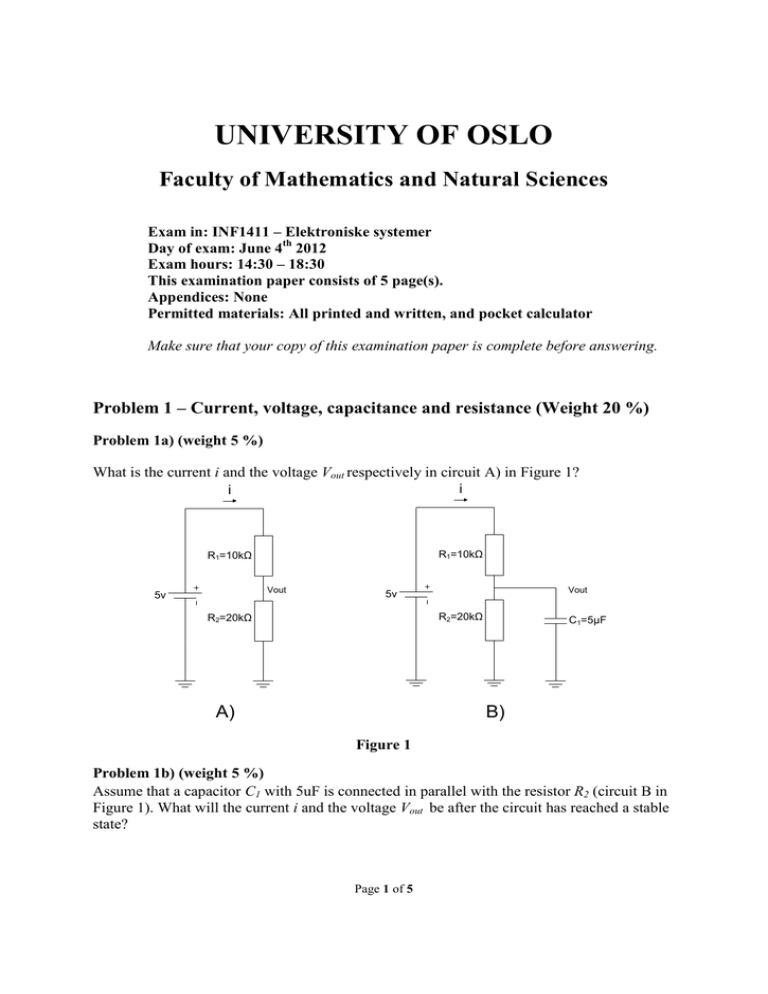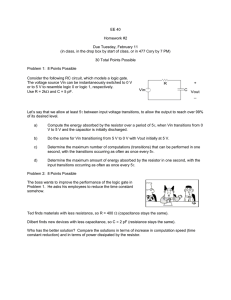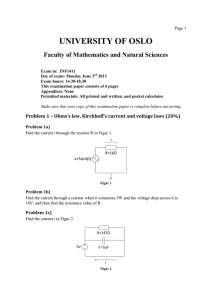UNIVERSITY OF OSLO Faculty of Mathematics and Natural Sciences
advertisement

UNIVERSITY OF OSLO Faculty of Mathematics and Natural Sciences Exam in: INF1411 – Elektroniske systemer Day of exam: June 4th 2012 Exam hours: 14:30 – 18:30 This examination paper consists of 5 page(s). Appendices: None Permitted materials: All printed and written, and pocket calculator Make sure that your copy of this examination paper is complete before answering. Problem 1 – Current, voltage, capacitance and resistance (Weight 20 %) Problem 1a) (weight 5 %) What is the current i and the voltage Vout respectively in circuit A) in Figure 1? i i R1=10kΩ R1=10kΩ Vout 5v Vout 5v R2=20kΩ R2=20kΩ A) C1=5μF B) Figure 1 Problem 1b) (weight 5 %) Assume that a capacitor C1 with 5uF is connected in parallel with the resistor R2 (circuit B in Figure 1). What will the current i and the voltage Vout be after the circuit has reached a stable state? Page 1 of 5 Problem 1c) (weight 5 %) Which value will Vout in Figure 1 B) approach if the battery is replaced by an alternating voltage source and the frequency increases more and more and becomes very large? Explain what happens! Problem 1d) (weight 5 %) Given the resistor network in Figur 2. Simplify the circuit as much as possible, i.e. find the total resistance between nodes A and B. In case you have forgotten your pocket calculator: Write down your answer as a fraction. A R1=2Ω B R2=1Ω R3=2Ω R4=4Ω R6=10Ω R5=4Ω Figur 2 Problem 2 – Impedance (weight 20 %) Problem 2a) (weight 7,5 %) Find the total impedance (both the phase angle and the magnitude) of the circuit at the frequency f=1 kHz and draw the phase diagram with R, XC, Z and θ. C1=0,1μF C2=0,2μF Vout Vin R1=750Ω Figur 3 Problem 2b) (weight 2,5 %) What happens with the phase angle θ if the capacitance of the capacitor C1 increases (and the other values remain the same)? Page 2 of 5 Problem 2c) (weight 5 %) What is the phase shift φ (the delay measured in degrees) between Vout and Vin (i.e. how many degrees leads or lags Vout with respect to Vin)? Problem 2d) (weight 5 %) Imagine that the resistor and the two capacitors switch place (i.e. the capacitors are now connected towards ground, and the resistor is connected between the capacitors and the voltage source. What will the phase shift φ between Vout and Vin be now? Problem 3 – Transistors (weight 20 %) Problem 3a) (weight 2,5 %) In which operating region of a BJT will a small increase in VCE result in a large increase in IB? RC RB VB VC VCC VE VBB Figur 4 Problem 3b) (weight 5 %) Given VCC = 5v, VBB = 2.5v, VBE =0.7v, RB = 100kΩ and β = 250 in Figur 4. Calculate IB og IC Problem 3c) (weight 5 %) What must be the value of RC in order for VC to be equal to 3 volts? Problem 3d) (weight 7,5 %) Given the amplifier in Figur 5: What is the function of C1, C2 and C3 respectively? Explain their function in the circuit (it is not necessary to perform any calculations here, just explain). Page 3 of 5 VCC RC R1 C2 Vout C1 Vin R2 RE C3 Figur 5 Problem 4 – Operating amplifier circuits (weight 20 %) Rin=10kΩ vin Rf=150kΩ vout RL=5kΩ + Figur 6 Problem 4a) (weight 5 %) What type of amplifier is the circuit in Figur 6, and what is the amplification A (assuming that the operating amplifier is ideal)? Problem 4b) (weight 5 %) Assume that Vin is a direct voltage (i.e. not alternating). What value must Vin be in order for a current of 1mA to flow through RL towards ground? Problem 4c) (weight 5 %) If Rin is replaced by a capacitor Cin, what type of function does the circuit in Figur 6 calculate? Problem 4d) (weight 5 %) Now assume that Vin is a sinusoid after Rin has been replaced by the capacitor Cin., and assume further that the behaviour of the circuit is ideal. For what point of sinusoid of Vin will Vout have its minimum and maximum values, respectively? (No calculations are necessary in order to answer this problem; it will suffice to refer to specific points on curve shapes) Page 4 of 5 Problem 5 – Multiple choice (weight 20 %) In each of the problems below there is only one correct statement. Your answer shall only be the number of the correct one. Read carefully through all statements within one problem before choosing the correct one! Problem5a (weight 4 %) 1. The inverse of impedance is called admittance 2. The inverse of conductance is called susceptance 3. The inverse of capacitance is called reactance 4. The inverse of inductance is called inductivity 5. The inverse of conductivity is called permittivity Problem 5b (weight 4 %) 1. Kirchhoff’s voltage law says that the algebraic sum of voltages in a node equals 0 2. Kirchhoff’s current law says that the algebraic sum of currents around a closed loop equals 0 3. Ohm’s resistance law says that the total impedance around a closed loop equals 0 4. The algebraic sum of currents into a node equals 0 5. The sum of voltages around a closed loop equals 0 Problem 5c (weight 4 %) 1. The impedance of an inductor is infinitely high for direct currents 2. The impedance of a capacitor is infinitely high for alternating currents 3. Physical inductors have no parasitic inductance 4. Physical capacitors have no parasitic resistance 5. Physical resistors may have parasitic inductance Problem 5d (weight 4 %) 1. A diode conducts current equally well in both directions 2. Zener diodes have lower resistance in the forward direction than regular diodes 3. The voltage drop across a diode in the forward direction is due to a potential difference across the depletion region 4. The barrier voltage is of the same size as the breakdown voltage, but with opposite sign 5. Diodes are not a type of semiconductors Problem 5e (weight 4 %) 1. An AD converter converts a digital volatge to an analog voltage 2. AD and DA converters can only convert voltages, not currents 3. A dual-slope AD can be designed to give as high a resolution as desired 4. The resolution of an AD converter is determined by the reolution of the analogue input signal 5. DA converters must always be designed with counters Page 5 of 5



